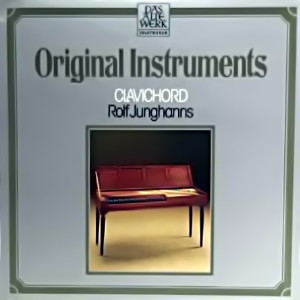 |
1 LP -
Telefunken 6.42073 AP (p) 1979
|
|
| ORIGINALINSTRUMENTE - Clavichord |
|
|
|
|
|
|
|
| Johann Christoph
Friedrich Bach (1732-1795) |
Sonatina
a-moll (aus: Musikalische
Nebenstunden, 1787/88)
|
|
13' 12" |
|
|
-
Allegretto |
4' 30" |
|
A1 |
|
-
Siciliano: Andante |
3' 17" |
|
A2 |
|
-
Rondo: Allegretto |
5' 25" |
|
A3 |
| Carl Philipp
Emanuel Bach (1714-1788) |
Sonata
V F-dur, Wq 55 Nr. 5 (aus: 6
Klavier-Sonaten für Kenner und
Liebhaber, 1. Sammlung, 1979) |
|
9' 01" |
|
|
-
Allegro |
4' 30" |
|
A4 |
|
-
Adagio maestoso |
2' 34" |
|
A5 |
|
-
Allegretto |
1' 57" |
|
A6 |
| Carl
Philipp Emanuel Bach |
Sonata
III h-moll, Wq 55 Nr. 3 (aus: 6
Klavier-Sonaten für Kenner
und Liebhaber, 1. Sammlung,
1979)
|
|
8' 09" |
|
|
-
Allegretto |
4' 12" |
|
B1 |
|
-
Andante |
1' 24" |
|
B2 |
|
-
Cantabile |
2' 33" |
|
B3 |
Wilhelm
Friedemann Bach (1710-1784)
|
Sonata
B-dur |
|
12' 35" |
|
|
-
Un poco allegro |
5' 05" |
|
B4 |
|
-
Grazioso |
2' 33" |
|
B5 |
|
-
Allegro di molto |
4' 57" |
|
B6 |
|
|
|
|
|
| Rolf JUNGHANNS,
Clavichord (von Carl Schmahl,
Regensburg, Ende 18. Jahrhundert,
aus der Sammlung historischer
Tasteninstrumente Fritz Neumeyer,
Schloß Bad Krozingen) |
|
5
|
|
|
|
Luogo
e data di registrazione |
|
Schloß
Bad Krozingen (Germania) - 1979
|
|
|
Registrazione:
live / studio |
|
studio |
|
|
Recording
Supervision
|
|
-
|
|
|
Edizione LP |
|
TELEFUNKEN
- 6.42073 AP - (1 LP - durata 42'
57") - (p) 1979 - Analogico |
|
|
Originale LP
|
|
- |
|
|
Prima Edizione CD |
|
-
|
|
|
Note |
|
Produced
by Toccata
|
|
|
|
|
The origins
of the clavichord
go back to ancient
times. This
instrument was
developed from the
monochord, a
resonance box with
strings, on which
the regular
relation of string
length to the
pitch of the tone
could be studied
by graduating the
string. Towards
the end of the
Middle Ages, it
appears as a
musical instrument
as the monochord
was combined with
the keyboard of an
organ. Small flat
brass blades, the
tangents, at the
end of the key
levers strike the
strings at
different points
and cause them to
vibrate when the
key is depressed.
The clavichord was
regarded as the
ideal instrument
“for study or in
general for
private musical
entertainment.”
Despite its
unusually low
timbre, it was,
for several
centuries, just as
widespread as the
harpsichord, as it
has a number of
superior
qualities: it is
small, light,
wieldy, is
mechanically
reliable and
simple which,
however, demands a
sensitive command;
it has a highly
agreeable sound
due to the great
variety of
overtones.
The era of
sentimentality
which followed the
change of style
towards the middle
of the 18th
century was the
golden age of the
clavichord. At
this time, it was
praised especially
for its dynamic
power of
expression and its
sensitive timbre
as the “solitary,
melancholic,
unspeakably
delightful
instrument ... He
who has an
aversion to
reveliy, fury and
tumult and whose
heart often
delights in sweet
sensations, will
pass by the
harpsichord and
the pianoforte and
choose the
clavichord”
(Christian
Friedrich Daniel
Schubart, 1785).
Throughout this
period, the
harpsichord
remained the
preferred concert
instrument,
whereas at the
time the
pianoforte had
neither the
richness of tone
of the harpsichord
nor the expressive
qualities of the
clavichord. Only
decades later
would it supplant
both of them.
Until then the
clavichord
remained the most
widespread
keyboard
instrument and was
called simply
“clavier.” It was
of great
importance in the
particularly
active musical
life of the German
burgher.
The most famous
performers on this
instrument were
the sons of Johann
Sebastian Bach,
especially Carl
Philipp Emanuel
Bach, whose
improvisations on
the clavichord won
the admiration of
his
contemporaries.
Although their
compositions for
clavichord were
also played on
harpsichord or
pianoforte, they
only attained
their singular
beauty when played
on the clavichord
with its
“responsiveness to
the stiriings of
the soul.”
The lack of
richness of sound
of this otherwise
so perfected
instrument has
often been
regretted.
Nevertheless its
particular charm
lies precisely in
the clavichord’s
faint whisper,
which demands the
listener’s utmost
concentration.
Therefore the tone
of the clavichord
should by no means
be amplified in
reproduction. Only
when the listener
plays the
recording so low
that he must
concentrate and
listen in total
silence, will he
understand the
exuberant praise
of the “mild
clavier.”
Rolf
Junghanns
(English
translation by
Elisabeth
Geiger)
|
|
|

